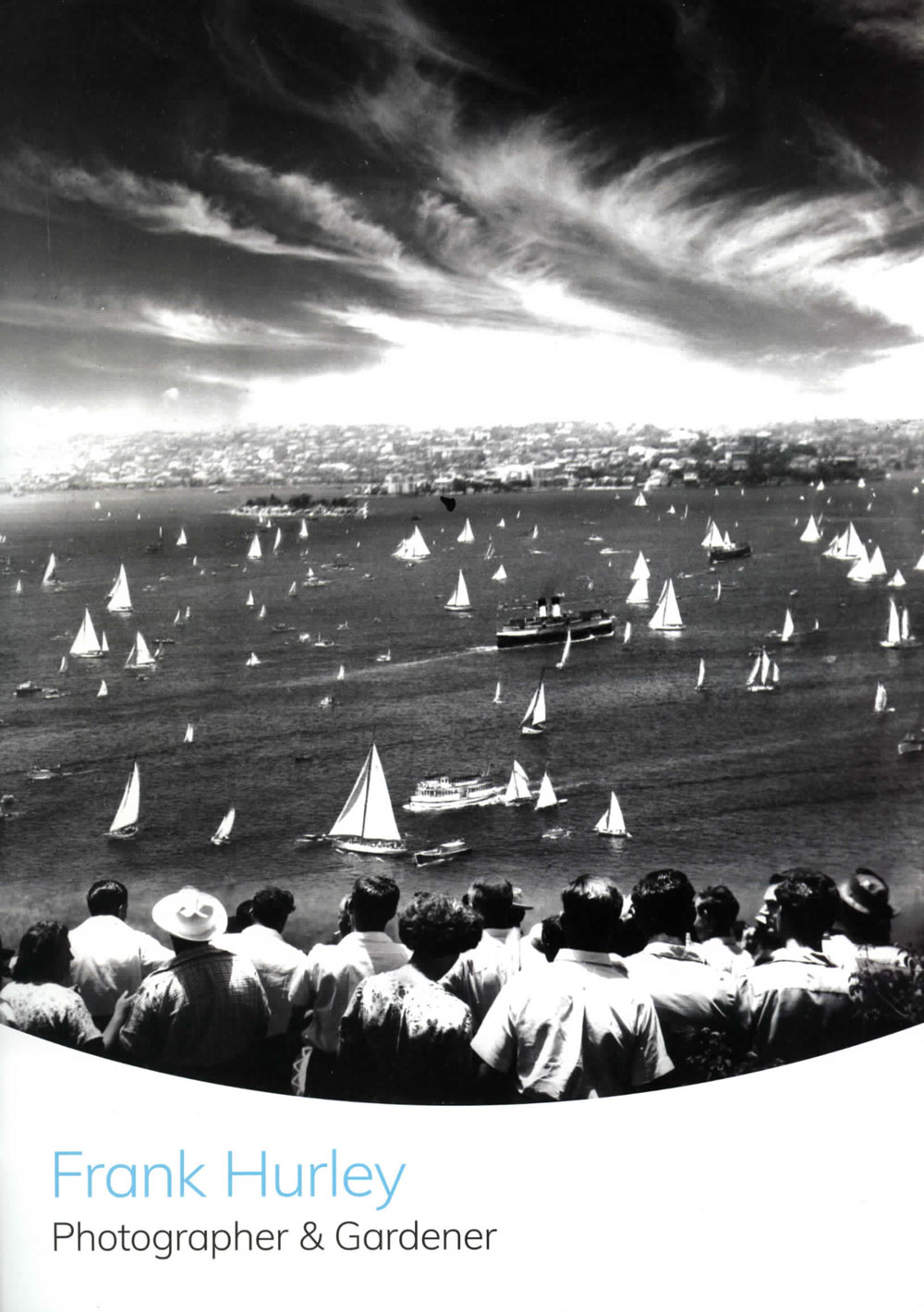 |
|
This is a digital version (with slight edits and layout changes) of the brochure produced by the Manly Art Gallery & Museum for the 2018 exhibition of the works of Frank Hurley. .
6 April - 14 October 2018
Manly Art Gallery & Museum. West Esplanade Reserve. Manly NSW
Guest curators: Gael Newton and Paul Costigan
Exhibition coordinator:
Katherine Roberts, Senior Curator. Manly Art Gallery & Museum
Exhibition black and white photographs have been digitally remastered from the digital files in the Notional Library of Australia Hurley collection.
Colour photographs of Australian native plants have been digitally remastered from Hurley's original transparencies in the De Beyer collection (now in the National Library of Australia).
Postcards and ephemera on loan from the Photoweb collection (now in the Manly Gallery collection).
Click here for the PDF of the original.
Image left used on the cover: Regatta on Sydney Harbour, c1948. NLA |
|
|
|
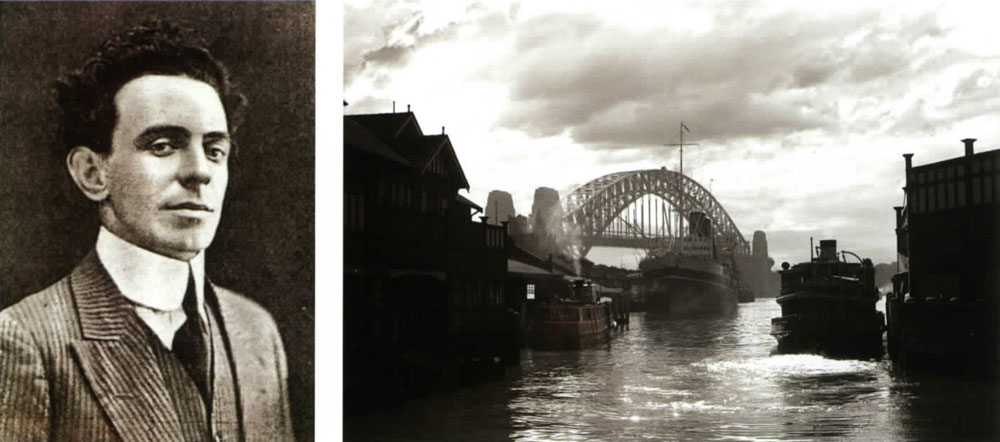 |
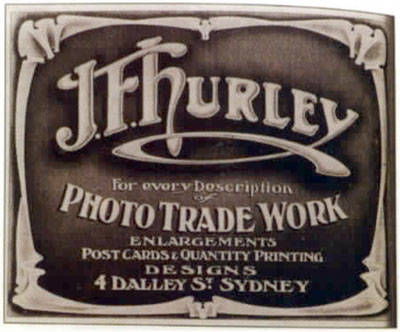
Clockwise from top left above
Frank Hurley. 1911, Australasian Photo-Review,
Nov 22.1911
Circular Quay looking to Harbour Bridge (detail),
C.1935.NLA
Business plate of J.F. Hurley. 4 Dolley Street, Sydney.
c.1906. image courtesy Photoweb collection |
The Boy from Glebe
The story of the early life of James Francis Hurley (1885-1962) as a professional photographer in Sydney, previous to his 1911 departure with Douglas Mawson for the Antarctic, has been overshadowed by the well documented and published stones about his later life and adventures.
Frank Hurley, the professional photographer, adventurer and author, started life in the working class suburb of Glebe. He went on to experience a full lifetime of extraordinary achievements.
In his last years, he continued his active professional life on the Northern Beaches of Sydney where he established an extraordinary garden that was a testament to his passion for Australian native plants.
The exhibition is structured to provide bookends to Hurley's life - with the first focus being on his photography in and around Sydney and the Northern Beaches, including Manly, and the second being on the photographs and postcards that reflect his lifelong engagement with Australian native plants.
The Professional Photographer
Frank Hurley started his photographic career around 1905. His professional interest may have started through an association with Henry Mallard, who was an assistant in Harrington's Photographic store in Sydney's George Street and an active amateur photographer.
Hurley's commitment to photography grew until he reached the point where his 'day job' interfered with his extracurricular interests; or according to the Frank Hurley story line, his employer, the Post and Telegraph Department, realised Hurley's dedication was elsewhere and asked him to leave.
Around 1906, Hurley was established in a position with Henry S. Cave, a lithographer and printer in Dalley Street, near Circular Quay, Hurley, being the young and energetic entrepreneur, was quick to secure a better position and so the firm became known as Cave and Hurley.
|
|
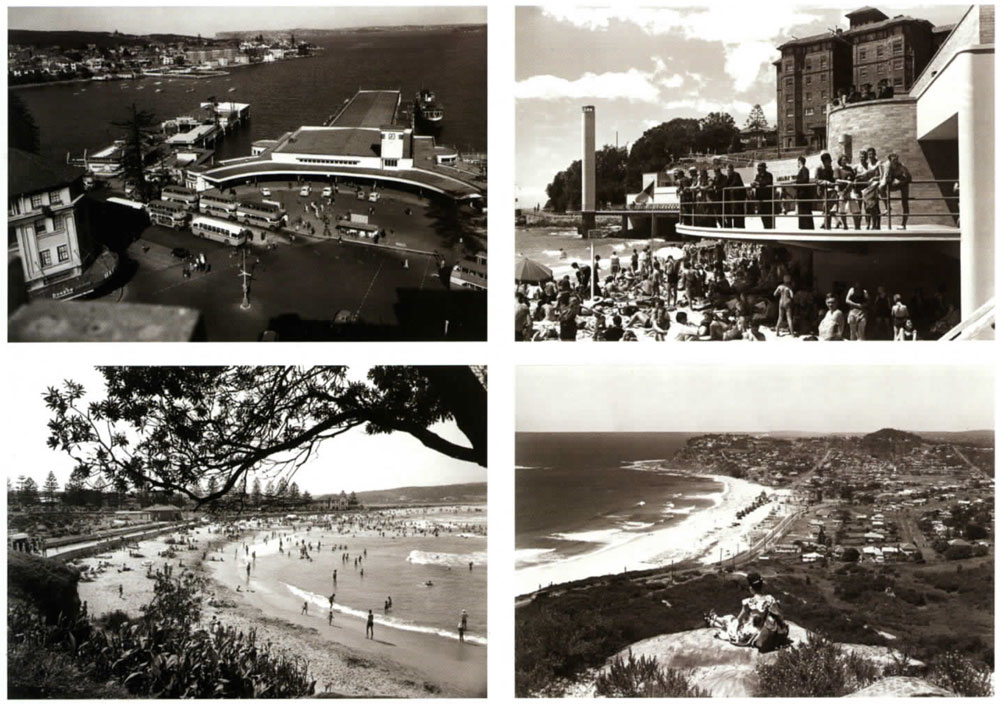 |
Clockwise from top left (above)
Manly Wharf and bus terminal, 1950s. NLA
Manly Surf Life Saving Club (detail). 1950s. NLA
Newport Beach. 1950s. NLA
Dee Why Beach, 1950s. NLA
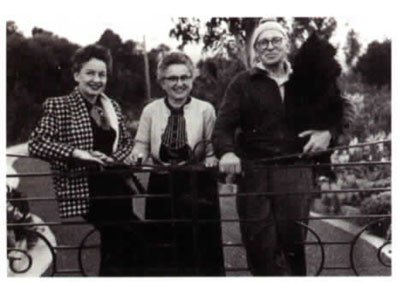
Hurley with his wife, Antoinette, and daughter.
Adelie, c.1960, Photoweb collection |
Hurley's Studio
Following the death of Henry Cave, Hurley established his own business producing stationery, postcards and photographs. It is during this time that his postcards appeared with various branding, such as FJH, or just 'Hurley' and later 'Frank Hurley'.
Hurley's studio, being close to Circular Quay, was very much in the centre of the action in early Sydney, and he was well positioned to travel by tram out to the coastal eastern suburbs and to cross the harbour to visit the northern suburbs and Northern Beaches, including Manly.
He spent his days capturing images for postcards as well as images for his own use.
It is most likely Hurley submitted images to newspapers such as the Herald, the Town and Country and to other journals.
At this time, 1907 to 1911, he developed many of the practices and dramatic aesthetic techniques that were to continue and underpin his life's work for the next half-century.
Adventures South & the World Wars
Hurley's achievements from 1911 to 1945 ore numerous and are well documented. As well as being involved in Antarctic voyages, he was an official war photographer in WWI and WWII. During his service, he was given the rank of Captain and awarded an QBE.
|
|
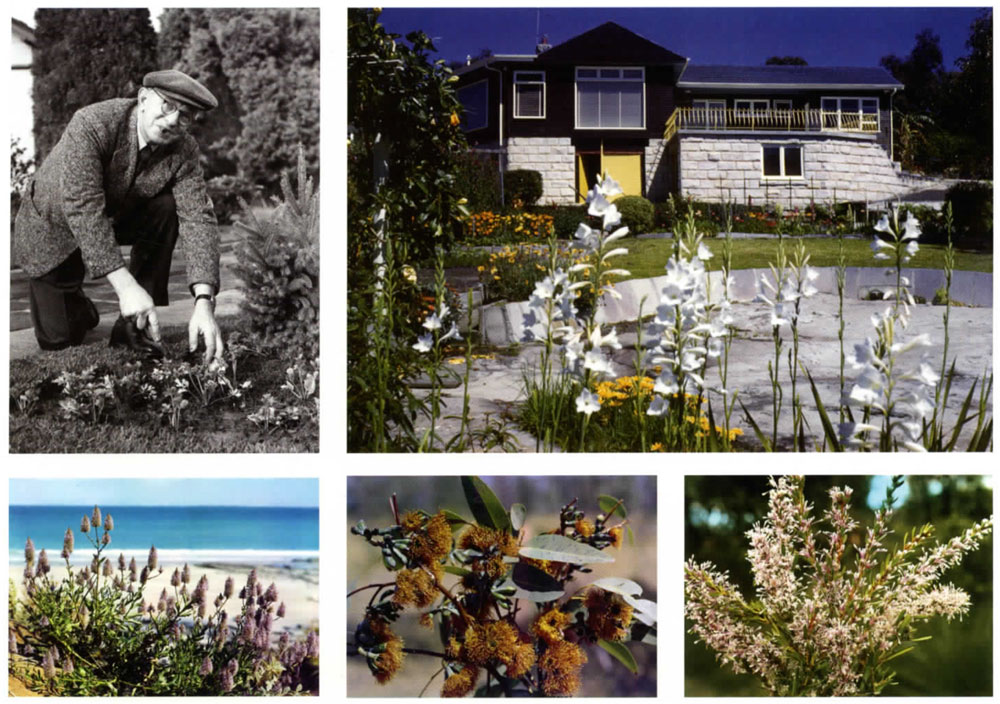 |
Clockwise from top left (above;
Frank Hurley in his garden ot Collaroy P/oteou
(detail). 1950s, NLA
Hurley's house at Edgecliffe Boulevard.
Collaroy Plateau. 1950s. NLA
Sapogon Axillaris. 1950s, the De Beyer collection
Eucalyptus Uinrata. 1950s. De Beyer collection
Pussy tails (Ptilotus Spothulatus), 1950s,
De Beyer collection
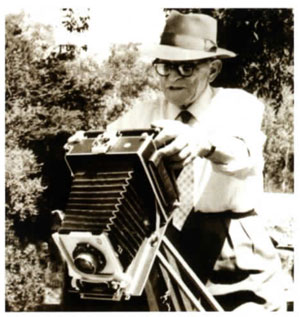
Frank with his camera, Perth, c.1958.
Photoweb collection |
Houses, Gardens & Native Plants
When Hurley was returning from WWI, he stopped off in Egypt where he met and married an opera singer, Antoinette Thierault.
They returned to Australia and. in the 1920s, established homes in and around Sydney Harbour, Their later homes, including at Rose Bay were enhanced by Hurley's growing passion for establishing gardens for his family of four children (Adelie, Toni, Yvonne and Frank).
Around 1950. the Hurley family moved to a new house on Collaroy Plateau.
The dominant feature of the house was (and still is) the large window on the northern side of the house that provides a panoramic view across Narrabeen Lake.
Hurley, who had seen many magnificent views internationally, was quoted as saying that his view over the Narrabeen Lake was better than any he had experienced anywhere in the world.
The original property was expansive and encompassed natural landscapes on the cliff face at the rear as well as room for a large garden. It was here that Frank continued a passion that started in his former households, constructing gardens beds, pathways and establishing a garden worthy of being classed as a 'mini botanical garden'.
Whenever Hurley was away from home, and this was often and for extended times, the job fell to Antoinette Hurley to ensure that the garden was well maintained. Relatives often speak of having visited to find her hard at work in the garden.
Hurley lived out his life as a resident of the Northern Beaches and would have been seen, when he was home from national excursions, catching the bus into the ABC offices or to attend meetings with his publishers and other agents.
|
|
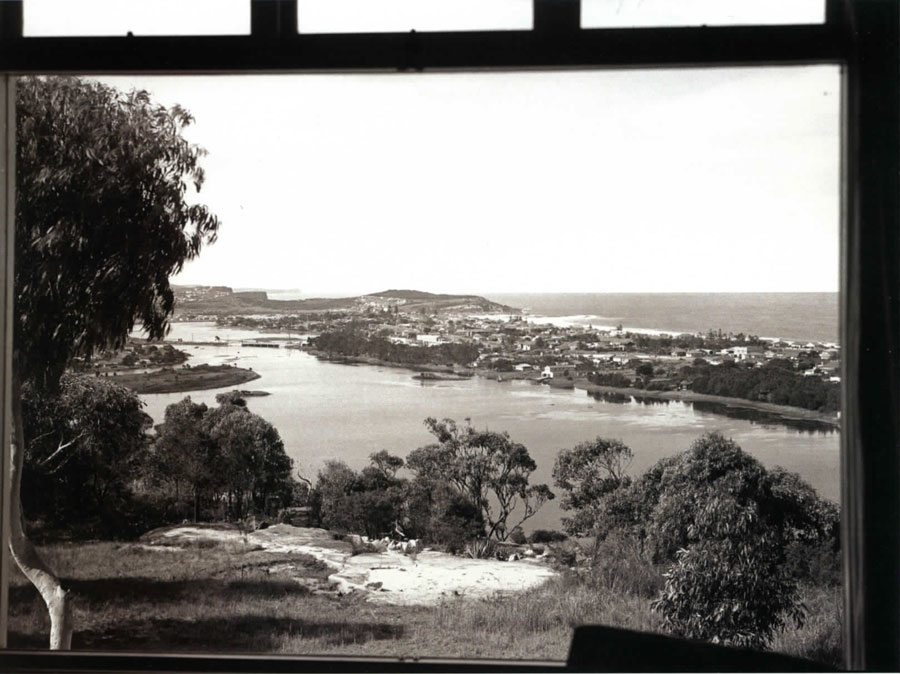 |
above
Hurley's home on Collaroy Plateau. 1950s. NLA
|
Collaroy Plateau & the Northern Beaches
Frank Hurley was a prolific producer of photography and associated publications throughout his professional life, until his death in 1962 at home on Collaroy Plateau.
A major part of Hurley's work in his years on the Northern Beaches involved authoring a series of publications including books, pamphlets. calendars and postcards.
While the major part of this production involved photographs from most of the states of Australia, there was also a constant theme - Australian native plants.
His work is represented in cultural institutions including the National Gallery of Australia, the National Library of Australia, the National Archives, the Australian War Memorial, Screen Sound Australia, the Mitchell Library in Sydney, and The Mawson Antarctic Collection, University of Adelaide.
Hurley sought and achieved recognition through his vision of the 'perfect' picture and through his many productions, he gained wide public acceptance.
It is significant that Frank Hurley chose the enticing ambience of the Northern Beaches area to live out his life. From here he produced an exciting array of publications and photographs, while also pursuing his passion for gardening and his interest in Australian native plants.
The life of Frank Hurley, Sydney photographer and native plant gardener, is a colourful part of the cultural heritage of Sydney's Northern Beaches.
|
|
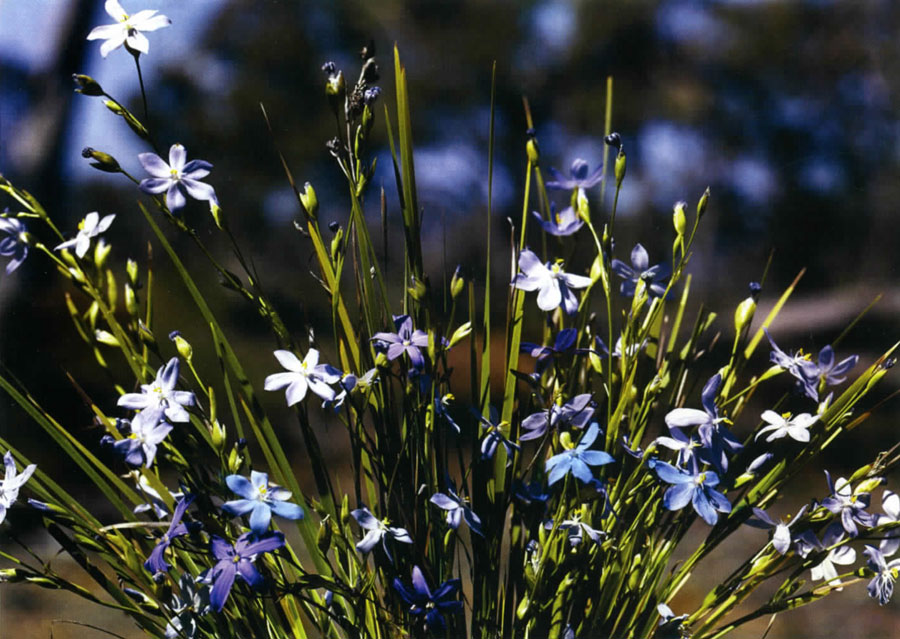 |
| |
above
Morning Iris, (orthrosanthus multifloris). 1950s. De Beyer collection
|
Photographer & Gardener
Exhibition 6 April - 14 October 2018
Manly Art Gallery & Museum. West Esplanade Reserve. Manly NSW
magam.com.au
Guest curators: Gael Newton and Paul Costigan
Exhibition coordinator: Katherine Roberts, Senior Curator. Manly Art Gallery & Museum
Catalogue ISBN: 978-0-9870621-5-4
© Curators for text and National Library of Australia and artist's estate for images.
No photograph printed in this publication may be reproduced without the permission of the copyright owner. All rights reserved. |
|
| |
|
|








